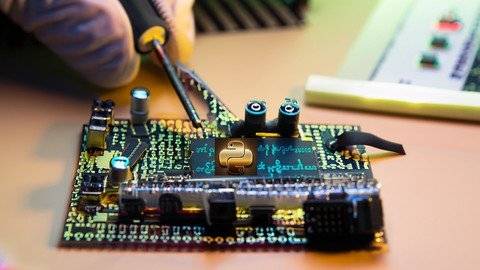
Python在现实世界中的应用,欢迎学习“使用Python实现硬件接口”课程!本课程向您介绍使用Python与硬件设备接口的基础知识。在当今世界,技术无处不在,与硬件组件连接和交互是许多应用程序的宝贵技能,包括机器人、物联网(IoT)设备和自动化系统。硬件接口是指使用软件接口与硬件设备(如传感器、致动器、电机和其他电子组件)进行连接和通信的过程。Python是一种流行的编程语言,它通过各种库和模块为硬件接口提供了强大的支持。使用Python进行硬件接口的优势:简单易用:Python具有清晰易读的语法,初学者和有经验的开发人员都可以使用。它允许您编写简洁而富有表现力的代码,降低硬件接口任务的复杂性。跨平台兼容性:Python是一种通用语言,可以在各种平台上运行,包括Windows、macOS、Linux和嵌入式系统,如Raspberry Pi和Arduino。这种跨平台兼容性允许您与硬件设备交互,而不管操作系统如何。广泛的库支持:Python提供了大量专门为硬件接口设计的库和模块。这些库提供了高级抽象,使得与传感器、执行器和其他设备的交互更加容易。它们处理底层细节,如数据传输协议,使您能够专注于应用程序的高层逻辑。与其他技术的集成:Python与硬件领域中常用的其他技术无缝集成,如数据分析、机器学习和web框架。这允许您利用Python的广泛生态系统进行数据处理、分析、可视化和硬件设备控制。硬件+ Python =未来如果你想快速使用Python函数,这门课程是为你准备的。为了创建具有更有效接口的应用程序,您可以在LabVIEW环境中试验不同的设计模板、框架和OOP结构。你也可以雇佣这个不可思议的团队来完成你的学术研究、论文和项目的大量任务!基于以前学生在本课程中的成功和他们的最终成绩,您可以放心,在完成本课程后,您将获得立即开始使用Python所必需的知识。Hardware Interfacing Using Python
MP4 |视频:h264,1280×720 |音频:AAC,44.1 KHz
语言:英语|容量:1.87 GB |时长:1小时52分钟
你会学到什么
了解数据采集的基础知识
集成Python和LabVIEW
数字信号产生和采集
模拟信号生成和采集
要求
Python的基础知识
课程目录
第一部分:导言
第一讲简介
第2部分:使用Python的USB DAQ
第2讲USB 6009简介
第三讲数字写6009 DAQ
第四讲多数字写6009 DAQ
第五讲数字阅读6009 DAQ
第六讲多重数字阅读6009 DAQ
第七讲模拟阅读锅
第8讲模拟写亮度
第9讲多路模拟写亮度控制
第10讲多路模拟读数电位计和触摸传感器
第11讲循环闪烁Led
第12讲亮度控制数字图书馆
第3节:使用Python的Arduino
第13讲使用Python产生数字信号
第14讲使用Python进行数字信号采集
第15讲利用Python产生多路数字信号
第16讲多重数字阅读
第17讲采集模拟信号产生数字信号
第18讲红外传感器
第四部分:测试你的知识
学生、行业人士
Python for Real world applications
What you’ll learn
Learn about the Basics of Data Acquisition
Integrating Python with LabVIEW
Digital Signal Generation and Acquisition
Analog Signal Generation and Acquisition
Requirements
Basic Knowledge of Python
Description
Welcome to the “Hardware Interfacing Using Python” course! This course introduces you to the fundamentals of interfacing with hardware devices using Python. In today’s world, where technology is ubiquitous, connecting and interacting with hardware components is a valuable skill for many applications, including robotics, Internet of Things (IoT) devices, and automation systems.Hardware interfacing refers to the process of connecting and communicating with hardware devices, such as sensors, actuators, motors, and other electronic components, using a software interface. Python is a popular programming language that provides robust support for hardware interfacing through various libraries and modules.Advantages of using Python for hardware interfacing:Simplicity and ease of use: Python has a clean and readable syntax, making it accessible for beginners and experienced developers alike. It allows you to write concise and expressive code, reducing the complexity of hardware interfacing tasks.Cross-platform compatibility: Python is a versatile language that runs on various platforms, including Windows, macOS, Linux, and embedded systems like Raspberry Pi and Arduino. This cross-platform compatibility allows you to interface with hardware devices regardless of the operating system.Extensive library support: Python offers a wide range of libraries and modules specifically designed for hardware interfacing. These libraries provide high-level abstractions, making it easier to interact with sensors, actuators, and other devices. They handle low-level details such as data transmission protocols, allowing you to focus on the higher-level logic of your application.Integration with other technologies: Python seamlessly integrates with other technologies commonly used in the hardware domain, such as data analysis, machine learning, and web frameworks. This allows you to leverage Python’s extensive ecosystem for data processing, analysis, visualization, and control of hardware devices. Hardware + Python = The FutureIf you wish to interface quickly with Python functions, this course is for you.To create applications with more effective interfaces, you can experiment with different design templates, frameworks, and OOP structures in the LabVIEW environment.You can also employ this incredible team to perform numerous assignments for your academic studies, thesis, and projects!Based on the success of previous students in the course and their final grades, you can rest assured that you will acquire the knowledge necessary to begin using Python immediately after finishing the course.
Overview
Section 1: Introduction
Lecture 1 Introduction
Section 2: USB DAQ using Python
Lecture 2 Introduction to USB 6009
Lecture 3 Digital Write 6009 DAQ
Lecture 4 Multiple Digital Write 6009 DAQ
Lecture 5 Digital Read 6009 DAQ
Lecture 6 Multiple Digital Read 6009 DAQ
Lecture 7 Analog Read – POT
Lecture 8 Analog Write Brightness
Lecture 9 Multiple Analog Write Brightness Control
Lecture 10 Multiple Analog Read POT and Touch sensor
Lecture 11 Blink Led For Loop
Lecture 12 Brightness Control numpy library
Section 3: Arduino using Python
Lecture 13 Digital Signal Generation Using Python
Lecture 14 Digital Signal Acquisition Using Python
Lecture 15 Multiple Digital Signals Generation Using Python
Lecture 16 Multiple Digital Read
Lecture 17 Acquire Analog Signal Generate Digital Signal
Lecture 18 IR Sensor
Section 4: Test Your Knowledge
Students, Industry Persons
1、登录后,打赏30元成为VIP会员,全站资源免费获取!
2、资源默认为百度网盘链接,请用浏览器打开输入提取码不要有多余空格,如无法获取 请联系微信 yunqiaonet 补发。
3、分卷压缩包资源 需全部下载后解压第一个压缩包即可,下载过程不要强制中断 建议用winrar解压或360解压缩软件解压!
4、云桥网络平台所发布资源仅供用户自学自用,用户需以学习为目的,按需下载,严禁批量采集搬运共享资源等行为,望知悉!!!
5、云桥网络-CG数字艺术学习与资源分享平台,感谢您的赞赏与支持!平台所收取打赏费用仅作为平台服务器租赁及人员维护资金 费用不为素材本身费用,望理解知悉!
6、For users outside China, if Baidu Netdisk is not convenient for downloading files, you can contact WeChat: yunqiaonet to receive a Google Drive download link.



评论(0)